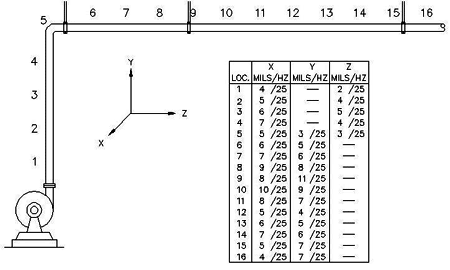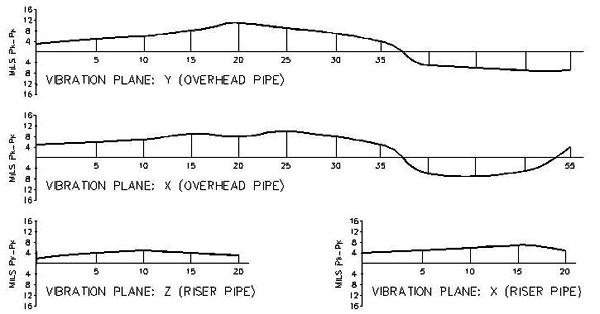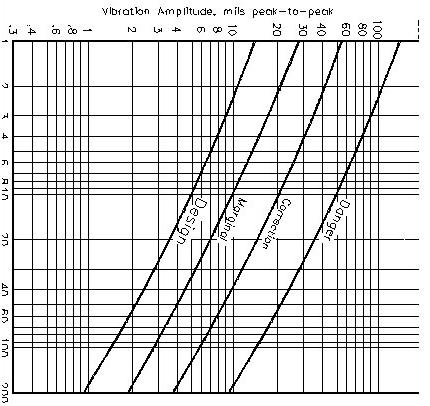Piping vibration can be an annoying problem
which can consume unnecessary maintenance activity and can affect pumping system
performance and endurance. The system includes the pipe, all piping supports, hangers,
snubbers, pipe to pipe interfaces, and machinery or devices attached to the pipe. All
these items can influence the pipe vibration patterns.
This testing method will
determine the piping system vibration amplitudes, frequencies, nodal points, and the pipe
modal shape. It can, also, be used to identify defective supports, incorrectly placed
supports, and the locations of maximum deflection requiring additional supports.
Analyzer/Data Collector
Many data collectors have internal circuitry with low frequency range limitations: output
displays in acceleration units are 2 Hz and output displays in velocity and displacement
are 5 Hz. This circuitry is an internal high pass filter set for a 2 Hz roll-off frequency
for acceleration signals and 5 Hz as the velocity and displacement roll-off frequency. The
filter eliminates excessive noise from being displayed.
This means that if an accelerometer is connected to the data collector and the display
is setup for acceleration units, the low frequency signals are correctly displayed down to
2 Hz. If the accelerometer signal is integrated to velocity or displacement the low
frequency limitation is 5 Hz. Similarly, a velocity transducer has the velocity low
frequency limitation and the integration limitation also applies.
Methodology
Piping vibration analysis involves describing how much the pipe is moving and at what
frequency the motion exists. The piping motion can be further described by showing the
motion as a modal plot. Pipes can vibration in three orthogonal directions just like a
machine. Vibration data should be collected in the X, Y, and Z axis. Since most data
collectors do not have the capability of calculating transfer functions collected from
impact/response input signals, all data collection should be taken while the pumping
system is operating.

The vibration transducer may be attached to the pipe using a magnetic mount without
affecting the lower frequency response of the transducer. The overall pipe length should
be separated into equal spaced lengths 3-5 feet ( 1-2 meters ) for this test and plotted
on a graph sheet. The pipe hangers/restraints and their orientation to the pipe should be
noted on the plot.
Setup the data collector for a frequency range for a 0-12,000 CPM (0-200 Hz) and
display units of acceleration (G's). Collect spectra at each measurement point. Evaluate
the spectra for the components at common frequencies noting their amplitude and frequency.
Corrective Actions
Generally, the pipe supports should be a nodal point with little or no motion. Excessive
motion at these locations indicate that the support is faulty or improperly installed.
Vibration amplitudes should decrease as a complex joint, such as a tee connection, an
elbow, or machine connection, is approached.
Convert all the collected data to
displacement units using the formula:
A = 14.2 x 10-9 x D x F²
where:
D = Displacement (mils pk-to-pk)
A = Acceleration (G's pk)
F = Frequency (Hz).

Plot all the amplitude information which is at a common frequency on the graph to
determine the modal shape at which the pipe is vibrating. Compare the calculated
amplitudes and frequencies with the allowable piping vibration levels chart to determine
if corrective action is warranted.

Wachel, J. C. and Bates, C. L., Techniques for Controlling Piping
Vibration and Failures, ASME Paper 76-PET-18.
The listed ASME Paper includes a "severity chart" which could be used as a
starting point in determining the piping system acceptability. This chart was compiled
from 25 years of data and may be overly conservative for long flexible piping systems
commonly found in power stations.
Pipe vibration correction will involve re-tuning the pipe system to a different
frequency. This may be accomplished by re-locating the pipe supports, installing different
supports, isolating the pipe from its hangers or joints, or installing expansion joints in
the pipe. Before any modification is undertaken another pipe analysis should be carried
out to determine that the modification does not violate other design parameters such as
machine coupling momentums or connection stresses.
Testing Checklist
- Piping System Defined
- Proper Accelerometer
- Graph Paper
- Analyzer Set-up
|

